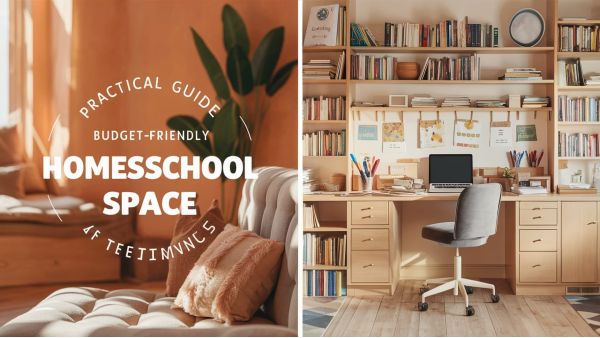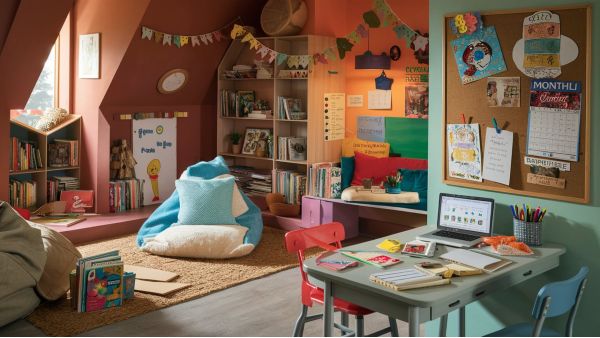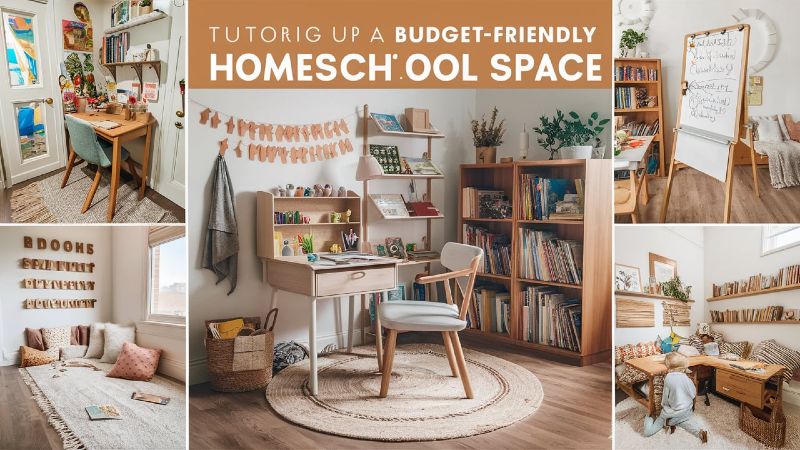A fixed learning space is necessary to make homeschooling work. Making a cost effective homeschool environment will assist you in providing a concentrated environment without having to forking out a lot of money. Resourcefulness and creativity with careful planning, you will be able to create a room that inspires and aids in the education of your child. The guide will teach you about selecting the best location, clever storage strategies, and all the essentials.
The Importance of a Specialist Homeschool Room
Having a homeschool area provides children with an illusion of space between school and home life. It assists in creating routine and pattern that is essential to successful learning. It possesses a designated place whereby all school items remain neat and in one point of direction. This saves time spent at set up everyday and it creates a sense of normalcy which is beneficial to both the parent and child.
Advance your career with must-have skills and explore AI in education. Try live tutoring platforms, manage homeschooling multiple kids, and find affordable homeschool curriculums. Explore more at Study.com.
The Right Place in Your Home
Take a look around your house and identify a location in which you can create your homeschool space. This may be an extra bedroom a corner of your living room or even a part of the kitchen table. Think about the level of noise in the lighting and the space you require. Quantification of the area will make you buy the right size of furniture.
The realistic Budget Establishment
Identify the amount of money you can dedicate to the homeschool space. Incorporate furniture supplies teaching equipment and decorations. Intend to take advantage to utilize as many things as you have at home. This will cut the costs and makes your budget manageable. It is important to remember that a decent homeschool area is not about fancy purchases, but instead legislation.
Selection of the most appropriate Learning Place
Choose a quiet place free of home distractions like the TV or the sibling noise. The farther one can be near a window the better since natural light improves mood and concentration. Arrange to have good ventilation that can allow the fresh air. The area needs to be welcoming and comfortable in order to make your child excited to go to school.
Vital Furniture to Buy
Begin by selecting a sturdy desk or table of appropriate size to your child. Select a form fitting chair with back support particularly in the event your child spends great deal of time sitting. What about adjustable furniture that can accompany your child as he grows? Use books and supplies storage bins or shelves. Do not furnish the area with things that do not add value.
Low Cost Creative Storage Solutions
Storage is what kills or cures a homeschool space. To open floor space, use wall shelves. Reuse containers around the house such as jars or baskets that can be used to share supplies. Put names on everything so your child finds it and puts it back. Make it a routine to clean up so the area remains compact and comfortable.

Educational Tool and Decor Incorporation
Put maps charts or flashcards on the walls to provide learning aids. During interactive lessons and brainstorming, use white boards or chalk boards. Introduce such sources of technology as tablets, laptops to access materials online but be careful about the amount of screen time and incorporate hands-on activities. Select the decor that can stimulate but not overwhelm.
Individualizing the Room to Increase Attendance
Allow your child to be involved in color decoration and installation. Show their art or their most loved quotes. The space is made special by personal touches and people feel like they own it. Make the room serene by painting it with calm-down hues like soft blue or green. Do not use distracting and bright patterns.
Remaining Flexible in Your Scenario
The learning style and needs of children evolve. Light furniture or furniture on wheels can be used to allow changes in the layout. Establish special areas to read writing crafts and studies. The flexibility makes the space functional even as your curriculum and the child interests change.
Using Minuscule Spaces to Homeschool
When there is little space, be creative and use the vertical shelves and compressible furniture. Utilize corners or space on the wall. Room-saving furniture like a folding desk becomes a shelf elsewhere. Supplies should be small and arranged to prevent cluttering of restricted areas.
Smart Shoppping for Homeschool Supplies
Get used stuff in thrift shops or on online shopping channels to save money. Visit the education websites and find free digital and printable materials. Trade books and resources with homeschooling families. DIY projects are a possible solution to developing cheap and customized learning tools.
Supply Organization
Subject or use frequency supplies. Keep your daily use items in a place where they can be easily accessible and store other items in bins or drawers. Store away visibility using transparent containers and label everything well. A tidy room will teach your child to be responsible and ensure the transitions are easier.
Development of a Peaceful and Effective Working Environment
Use dark or curtains to control lighting to eliminate glare. Have comfortable places to read, like soft rugs cushions or bean bags. Such noise reduction devices as headphones or white noise machines may be considered. Maintenance the room clutter-free so that very little distracts and promotes concentration.
Provision of Movement and Break Areas
Exercise improves learning. Identify a corner or a space to rest through stretching or movement activities. Work on balance balls or standing desks to sit in a better position and maintain energy levels. Take frequent snack exercising and resting breaks to support focus in the lessons.
Technological Wise Use
Introduce devices such as tablets or computers to use videos games and online courses. Minimize and monitor the use of the screen. Mix computer balance with offline methods like reading puzzles and crafts. Apply educational apps consistent with teaching objectives and curriculum.
Seeking Your Child to Participate
Ask your child what he/she likes the homeschool would be like. This generates anticipation and sense of ownership of space. Their contribution can be used to personalize the environment to the way they learn. Follow up regularly and modify the arrangement as the interest and needs of your child change.
Refreshing Your Homeschool Space Gradually
Once a season, review your homeschool area. Discard off-dated materials and worn furniture. Use various learning aids to make lessons fresh. Adjust according to what goes and what does not. Maintaining an active environment enhances unending activity.
Keeping the Space in its Regular Order
Designate one day when you can clean up the homeschool room every week. Engage your child on cleaning up and sorting. This creates healthy formed habits and respect towards the learning environment. People should check the supplies and replace them to prevent disrupting the lessons.
Linking Your Homeschooling Space to the Real World
Make your space your starting point to visit museums local libraries science centers and community events. Extend the learning in the classroom by field trips and doing. Make it your child s habit to write up these outings and talk about them in the homeschool area.
Tricks of Homeschooling Many Children Vacating a Single Space
Workstations or schedules should be created individually so that the child is not distracted. Color code or label supplies to help organization according to child. Promote team projects through collaborative work projects. Adaptability and communication enhances harmony and productivity.
Establishing a Homeschooling routine
Introduce regular lesson start and end times in the space. Establish routines like arranging the materials with one another or some light warm-up practice. A routine allows children to get their minds into gear and relax afterward. Leave schedules on the floor so everyone can remember what the day entails.

Boost your learning with these free online platforms with certificates and learn coding at home step by step. Improve study habits using note-taking strategies and memorization techniques.
Pros and Cons of a Budget-Friendly Homeschool Space
| Pros | Cons |
|---|---|
| Saves money while creating a learning zone | May require compromise on furniture style |
| Encourages organization and discipline | Takes time and effort to set up |
| Promotes child’s independence | Space limitations may restrict options |
| Provides a calm environment for focus | Needs regular updates to stay effective |
Frequently Asked Questions
Q1 What are the tips to setting up a homeschool in a small apartment?
Vertical storage and other multi-purpose furniture can be used using foldable desks. Choose a corner spot and clean up. Paint the room in light colors to make it appear more spacious. Engage your kid into preparation of supplies.
Q2 How do I find inexpensive sources of homeschool supplies?
Purchase second hand goods at thrift shops and the Internet. Take printables and virtual learning games. Take out books at the library or trade with other homeschooling families. Do-it-yourself is a cost-saving venture as well.
Q3 How do I keep my child engaged in homeschooling?
Make a vacant area to get rid of distractions and illumination. Put in practical and participatory learning activities. Plan time off and physical activity. Tailor instruction to the interests of the child.
Q4 How often should I upgrade my homeschool area?
Review as your child matures or has different requirements in learning. Go through the area season by season, to de-clutter and update. Fix old materials or furniture whenever necessary. Tune according to what is best.
Q5 Is it possible to equip two children with a home homeschool room?
Yes in a planned manner. Assign different work places or work routines. Label everything with different colors according to the child. Foster collaborative work and Shared responsibilities.
Final Thoughts
Creating a homeschool space on a budget will require some effort and imagination, but the payoff is an efficient learning environment. Use the available space budget and evaluate the needs of your child. The best way is to make a homeschool space comfortable and productive with use of affordable furniture smart storage and personal elements. To learn more homeschool tips, visit instituteinfo.

